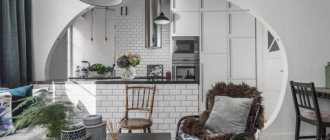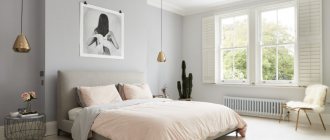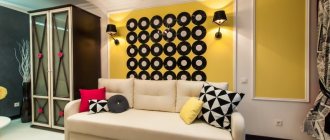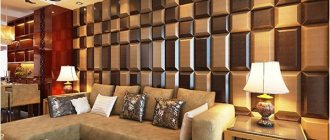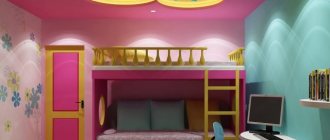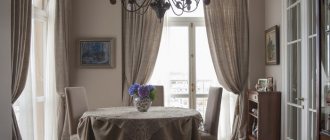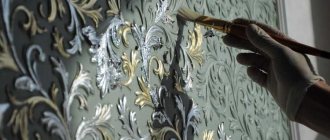Manual drawing techniques
If you want to create something unusual, exclusive and unique, then pay attention to creating drawings on the walls using manual techniques. This can be painting walls with brushes, markers, graffiti, airbrush or a combination of several techniques
Paintings
One of the classic, but at the same time original options is to decorate a wall with a painting. Before you buy a work of art, you should understand that paintings can be completely original and those that are created according to a specific template.
Before choosing and purchasing, especially if it is difficult to choose or navigate the huge selection of paintings, it is better to seek help from a gallery consultant or designer.
Seal
Another great solution to apply a drawing or image to the wall is printing. The printed design can be applied to any surface. Varieties of such equipment can be posters, photo wallpapers, printed pictures.
If we talk about the advantages of printing, then, naturally, it is low cost.
The downside is that it cannot be compared with a design that is applied directly to the wall, and it is also impossible to stick the print on an uneven wall, corner, or niche.
Stencil painting
A stencil is a special sheet with decorative elements and figures cut out in it. They can be reused many times. Drawings on walls covered with wallpaper, plastered or painted can be made using stencil painting. The stencils are quite easy to use.
The essence of this technique is to apply paint through the holes of thick cardboard or other material.
With the help of properly selected stencil painting, the walls will become bright and some imperfections will be hidden.
In order to decorate the walls of your apartment with stencil painting, you do not have to have artistic talents. It is enough to buy, order or make your own stencil, with which you can easily apply the design to the wall.
The best material for a stencil is thick cardboard, in addition to which you will need a brush with fine bristles.
Before you start painting the walls, the stencil must be secured. For this you will need masking tape.
The best pattern and paint option would be calm tones that match the wall decoration. This pattern will not bore you. It's also best to choose lightweight templates, but don't overdo it! Choose a drawing that you like and work on it with pleasure.
Choice of colors
Not all parents pay due attention to color when covering walls. Often the palette is selected according to the situation, but this approach cannot be called correct, since color has a strong impact on the development of the child.
The shade of the walls can affect the physiological and psychological processes of the child.
Wall decoration in a nursery should be selected based on the capabilities of each shade:
- Choosing red will increase the child's activity, but it needs to be diluted with other shades.
- The yellow palette has a direct impact on mental development. It is often chosen for children who are in school and have problems with concentration and perseverance.
- Orange colors will give your baby a feeling of joy and contentment.
- The blue tint will calm the baby. In addition, this color affects the development of imagination and the desire to learn something new.
- Green areas in wall cladding promote sound sleep and maintain a good mood.
- Pink walls will make your child feel cozy and comfortable, reduce his aggression and lift his spirits.
You can decorate the walls using various drawings or photographs.
A good option for the color scheme can be seen in the next photo.
Wall cladding should not be too bright, as this may tire the baby. The same applies to dark decor, which can greatly lower a child’s mood.
Stencil painting
The easiest way to paint the walls in a nursery is to use stencils. You can purchase ready-made blanks at any construction supermarket or make them yourself. For self-production it is enough:
- prepare cardboard or thick PVC film;
- find the desired image on the Internet and print it;
- cut out the design and attach it with tape to the prepared cardboard or film;
- Trace the contours of the image and cut it out using a stationery knife.
The finished stencil is attached to the wall and, depending on what is planned, is outlined for subsequent painting or covered with single-color paint using a sponge or sprayer.
When choosing a drawing, it is important to take into account the overall interior of the room and the interests of its occupant. For example, you can make ornaments with butterflies at the head of a girl’s bed, or sea or pirate attributes in a boy’s room
Plant-themed drawings will perfectly complement any children's interior. It won’t be too difficult to make your own wood stencil. By adding a few decorative items to the wall, it can be turned into:
- cherry blossoms in the girl’s bedroom;
- family tree in the boy's room.
Selection of materials for painting
Paint for covering walls in a children's room should have the following characteristics: hypoallergenic;
- moisture resistance;
- breathability;
- resistance to external influences and mechanical damage.
The following types meet all of the above requirements:
- acrylic;
- water-dispersion or simply water-based emulsion;
- silicone;
- latex;
- environmental paints.
Paints and varnishes without toxic components are suitable for painting the walls of a children's room.
- Acrylic paints dry quickly, have virtually no odor, form a highly durable matte surface when dry, and are easy to clean.
- Water-dispersed ones are odorless, dry very quickly, are breathable, easy to clean and inexpensive.
- Silicone paint is a very durable, modern material designed for painting walls. It is both waterproof and vapor permeable, which is why it is often used for bathrooms.
- Latex. This paint fits well on walls and holds tightly. The painted surface is very pleasant to the touch.
- Ecological paints feature exclusively natural ingredients. The name itself indicates suitability for finishing children's rooms. The only disadvantage of such paints is their high cost.
How to choose a drawing
The choice of painting theme should depend on the room in which the painting is planned.
If you are painting a living room, then it is advisable to choose landscapes, beautiful flowers, trees. Of course, mountains and coniferous forests will look original, but a professional can draw them carefully.
But it won’t be difficult to depict dandelions and lilies on the wall. To make the ornament truly interesting, it is advisable to use the above-mentioned stencil.
For the kitchen, the ideal option for wall decoration, given the vast majority of classic designs, is a still life made in the colors of bright vegetables. Most will be able to draw a plate of fruit and glasses of wine with sliced cheese with interesting patterns. The main thing is to settle on a drawing that is relatively easy to execute.
Have you seen a photo of a wall painting and are inspired by the idea of repeating the drawing yourself, but are you upset that you had no previous experience in fine art? No need to worry in advance
Just pay attention to the following techniques:
- Drawing made along the contour;
- Stencil;
- Drawing using slide projection.
Choosing colors for painting and wallpaper depending on the floor
Of course, boys and girls at any age gravitate towards different shades. Even psychologists note that it is better for a girl to grow up surrounded by some flowers, and a boy – with others.
This is important for the formation of a healthy child’s psyche
Design for girls
For a little princess, it is worth decorating a room in delicate, girlish colors. You can take pink-lilac or purple colors, very delicate and airy.
The combination of two or three colors of the rainbow allows you to create an original design for a children's room.
White-beige, light peach and sand wallpaper or paint will look great. It is better for the walls to be slightly textured, with a soft matte and silky effect.
A small room should be decorated in light shades, and to avoid a “hospital” interior, one of the walls can be covered with interesting wallpaper
But too bright, flashy colors and sharp contrasts are not suitable, they will make your girl irritable and restless. The room should be like a princess’s bedroom: everything should breathe tenderness and peace, but not be cloying.
Design for a boy
But the boy can be offered brighter ones. Fun colors. Yellow, warm green, rich blue – boyish shades. The little adventurer will be delighted with the pictures on the wall, or the world map or the starry sky. After all, he is so inquisitive!
“Real” treasure island in the interior of a children's room
But you need to use dark shades in a boy’s room carefully and in doses. If you use red, dilute with white, blue, brown
Use dark ones to highlight contrasts, and take softer and calmer ones as a basis.
For children of different sexes
If children of different sexes live in the room, you can also make them happy by decorating the room in beautiful and correct colors. Moreover, in such a way that both boys and girls will find the shades suitable and will like them.
To please both children at once, you can use the principle: each child has his own color
An excellent option is a room in light, neutral colors. The walls can be sand-colored, the furniture can be gray or the color of natural wood. Such a bright bedroom will not only look stylish, but will also maintain a clean and airy feeling.
Companion colors will allow you to divide the room into zones while maintaining the integrity of the interior
A more cheerful option is a sunny yellow-brown bedroom. The walls can be yellow; one wall can easily accommodate a landscape, for example, with giraffes and a savannah. Complete the design with brown furniture, an orange rug and decor from this range. Very sunny and cozy!
Winning color combinations.
Choose decor color combinations
Color combinations for the nursery can be easily selected on the website color.romanuke.com. Choose a color combination that you will adhere to according to the color cards on the site. This simple step will allow you to create a seamless, complete interior that all your guests will admire!
For convenience, we will divide children's ones into 3 color types.
In light colors
Especially typical for young children and easily excitable children. It is known that the environment greatly influences a person's behavior, so if your little one has difficulty calming down, choose a restrained color scheme.
Dark gamma
Dark children's ones look very fashionable and unusual. The main thing here is to know when to stop. You shouldn’t paint all the walls of the room in a dark color, but one, and even with skillfully selected decor, will look very advantageous.
In bright colors
Gone are the days when a nursery was associated with unimaginable combinations of eye-catching colors. “Children love everything bright” is a stereotype that adults themselves propagate. An excellent criterion for understanding whether the interior is good is to ask yourself whether it is pleasant for you to be in it. Children are future adults and the same laws apply to them as they apply to us. Instill taste in children from an early age. Bright colors in the nursery are a great option if used in doses. Light green furniture, pink wallpaper and colorful textiles are clearly too much, but the carefully adjusted bright details are quite enough!
In the hall
The hallway is the first room that your loved ones, family and friends who come to visit you see. This is where people get their first impression of you when renovating.
When thinking through the interior, pay special attention to this room, consider decorating the walls with patterns. Drawings in the hallway can visually expand the walls or dissolve the ceiling in the sky and clouds
The hallway is the perfect place to create an illusion. Ornaments, wall paintings, and various patterns are suitable for a large hallway.
Wall drawings are a non-innovative, but still original solution for decorating your apartment or house. Wall painting can create an atmosphere that will highlight your individuality and make the room unique and cozy.
Mural on the wall in a nursery for a girl and a boy
Fresco in the interior of a children's bedroom
If you want the nursery to change beyond recognition, then try decorating it with a colorful fresco. But keep in mind that creating such a masterpiece requires certain skills. Therefore, if you don’t want to waste money on materials, then try to find a professional who will quickly bring all your ideas to life.
In this case, you only have to tell the master about the child’s preferences, and he will literally create for you an original and unique fresco in a child’s style in a matter of hours.
Mural ideas for boys:
- Space
- racing track
- Pirate Island
- Spy laboratory
- Bridges
- Safari
Mural ideas for girls:
- View from the window
- Picturesque waterfalls
- Fairytale castles and princesses
- Flowers
- Still lifes
Hand painted walls in the interior of different rooms
For each room, you should choose an image, as well as a color palette, depending on the overall interior concept, the style of the room, as well as its intended purpose.
Bedroom
The bedroom is a place of relaxation
Here it is important to stick to restrained and calm shades and images, avoiding aggressive themes. Wall paintings should not be painted depicting whirlpools, waterfalls, or raging elements.
Withering plants and predators in the bedroom are also not appropriate. When choosing a pattern for painting the interior of the bedroom, you can use the rules of Feng Shui. Below is a table of the most suitable pictures for the bedroom.
You can also create an original drawing
Plants and landscapes are most appropriate in the bedroom
For the bedroom it is better to use calm shades
| Image | What does it symbolize |
| Blooming trees and peonies | Powerful love amulet |
| Butterflies | Amulet of happiness and love. The nuance here is the obligatory presence of a pair of butterflies. |
| Pair of birds | Marital fidelity and mutual feelings |
| Pomegranate fruit | Symbol of the imminent arrival of a child in the family |
| Calm sunny landscapes | Symbolizes a calm and measured family life |
Living room
This room is the main one in the apartment. This is where the family spends most of their time; holidays and receptions are also held. This area should be decorated with picturesque paintings that embody joy and comfort. The best choice may be:
- reproductions of famous paintings;
- natural and seascapes;
- city images;
- abstraction.
Also, when choosing a painting, you should base it on the style of the room:
- for a classic or Victorian style, antique columns overlooking the sea and images of a blooming garden will harmoniously fit into the interior;
- hi-tech or minimalism goes well with black and white abstraction or the look of a modern city;
- for an ethnic style, you should select paintings depending on the country and its culture that you wanted to embody (sakura blossoms for Japanese style, pyramids for Egypt, the Champs Elysees and the triumphal arch for a French interior).
Cityscapes with nature are perfect for the living room
The living room should be decorated with picturesque paintings
Kitchen and dining room
The nuance of wall painting in the kitchen interior is the choice of its location. You should not paint the wall near the sink or stove. Constant contact with water and temperature changes can negatively affect wall paintings. If this arrangement is important for the kitchen owner, you should choose moisture-resistant paints for the job, and also coat the creation with several layers of varnish.
To visually expand the room, a landscape, an imitation window or a picnic in nature are perfect. These are the most popular design techniques.
If the goal of interior wall painting is to create a specific atmosphere, the optimal solution may be:
- Still life;
- Image of a dining area in a cafe or restaurant;
- Coffee fantasies and paintings with berries and fruits.
After application, the drawing should be treated with protective agents.
Landscapes are perfect for the kitchen
The drawing should be applied on a wall where there is no furniture
Bathroom
The main factor that stops customers from painting walls in the interior of a bathroom is the increased humidity of the room and regular contact of the walls with steam. These aspects can significantly spoil a wall creation, but modern techniques and materials make it possible to avoid such negative aspects. In such situations, you must adhere to the following rules.
- Use moisture-resistant plaster.
- The work is carried out with special moisture-resistant paints.
- Cover the painting with several layers of protective varnish.
By following all these rules, the drawing will serve its owner for many years without losing its aesthetic properties.
An original solution for the bathroom would be an image of the seabed on the walls along with its inhabitants.
Drawings with a marine theme are suitable for the bathroom.
The drawing in the bathroom should be treated with protective agents
Children's room
Flights of fancy for painting walls in a children's interior are not organic. When choosing a design style, you should consult with the young owner of the apartment. Wall painting can turn a room into a fairy tale, creating an atmosphere of magic.
From a psychological point of view, you should not use aggressive images and flashy colors for wall painting in a children's room. Here you can use:
- underwater landscapes;
- fairy forest with fairies and animals;
- magical castles;
- cartoon characters and landscapes.
It is worth giving preference to calm and neutral colors for the wall background, but the characters themselves can be drawn in a bright and expressive style.
Ideas for Beginners
Not everyone can boast of having artistic abilities. Not everyone can afford the services of a professional either. In this case, you can use stencils or limit yourself to simple geometric elements. Everyone, without exception, can handle this type of work, regardless of their existing drawing skills. This design will fit perfectly into the decoration of a girl’s room and a boy’s interior. You can make original decor that will make the decoration unique and inimitable. The ideal option is to listen to the plans and ideas of the child himself.
Clouds using a stencil
Clouds will perfectly complement elegant and delicate interiors. Such images are very easy to apply either using stencils or by hand. However, templates will allow you to create identical elements.
To complete the work you will need:
- stencil with the image of a cloud;
- foam roller;
- blue acrylic paint for the background and white for the clouds;
- matte varnish to create a protective coating for painting elements.
Step-by-step instruction
- At the first stage, we create a background in the form of a blue sky and wait for the paint to dry completely.
- We apply the stencil to the wall according to the sketch or in any order.
- We put white paint on the roller and roll the cut out section of the stencil.
- Carefully remove the stencil, wait for the elements to dry and coat them with varnish.
This decor is suitable for both the upper part of the walls and the ceiling.
Trees and plants
Floral designs are ideal for decorating children's rooms, especially if their owner is a female person. Little beauties will be delighted with the colorful chamomile field, and for a teenager you can choose ornate floral patterns or 3D images of flower buds. Flowers always bring tenderness and a warm spring mood to a room.
A grove with delicate birch trees and fairy-tale animals, exotic trees with bright birds, individual branches with miniature green leaves, blooming sakura or a whole garden of apple trees covered with delicious ripe fruits will look great in a little girls’ room.
The tree can be placed in the center of the wall or in the corner, creating a charming fairy-tale area. The crown can be extended and brought to the ceiling. You will get the feeling that you are under a real oak or birch tree.
Cartoon characters
What child wouldn’t want characters from his favorite cartoons and games to live in his room? Girls, of course, will choose fairy-tale princesses and their funny helpers - mice, gnomes, birds. Boys will prefer images or emblems of Superman, Spider-Man, Batman. You can complement the image by placing his attributes near the character - Cinderella’s shoe or pumpkin carriage, a basket of pies or Little Red Riding Hood’s grandmother’s house, a turnip, running boots.
Geometric figures
Geometric shapes, outlined or filled, will always come in handy in any children's room. They can be arranged in rows, in a checkerboard or chaotic order. Circles, triangles, rhombuses, squares add dynamism and brightness to the interior. It is impossible to “grow out” of this option. It is suitable for both a baby’s room and a teenager’s home. The figures can be alternated, tilted, superimposed on one another - here your imagination is not limited in any way. If you like the latest design option, do not forget that each previous layer must dry completely before applying the next one, otherwise the paints will mix and the pattern will acquire unclear outlines and a dirty tint.
Beautiful inscriptions
You can use inscriptions to decorate the room. A bright alphabet would be very appropriate on the wall in the rooms of older preschoolers and first-graders. This element of the interior has not only a decorative role, but also a very practical one - the child will learn letters faster and begin to master the skill of reading. Older children can choose a saying they like, a call to visitors to the room, a slogan with strong energy, a favorite poem or the lyrics of a song that inspires them. For lyrical poems, it is better to choose an exquisite calligraphic font.
World map
A wall-sized geographical map will enrich the child with knowledge about the structure of our world and will allow him to remember the continents, countries and their capitals. It can be physical, political, or even ancient. Of course, you can hang a regular paper version, but the painting is more durable and fundamental. In addition, it is unlikely that you can find a paper map covering the entire wall.
In addition to the map, you can purchase a talking pen with special stickers. By encoding and sticking them on certain places on the card, you can listen to the recorded information. To do this, you just need to touch the sticker with the tip of the pen, and the device will immediately tell your child the name of the country, its capital, and tell you about the population and attractions of a particular area.
Such decor helps create the right atmosphere in a themed interior. For example, in the room of a little “sea wolf” a treasure map is very appropriate, which will be an excellent companion to a pirate chest upholstered in clapboard, a crib reminiscent of a ship’s deck and characteristic decor in the form of anchors and steering wheels.
The main points of creating decor using a stencil
Geometric patterns are considered the basis for creating a template. This is due to the presence of clear boundaries.
Such patterns are best suited for beginners in this business. After the final decision on decorating the surface has been made, you need to buy a template in the store. The second option is to do it yourself.
The resulting template is fixed to the selected surface. To apply the design, various paints are used - water-based, acrylic or enamel.
A small roller or foam sponge is best suited for this; aerosols are sometimes used. It is better not to use a brush when working with stencils; this is due to paint flowing over the edges of the template. As a result, the drawing turns out spoiled and unclear.
Using a stencil is an economical option for replacing standard wallpaper
The model is removed only when the drawing is completely dry.
Useful advice! Use a small amount of paint for application.
This will prevent drips from forming. If the area turns out to be poorly painted, it must be carefully touched up with a brush. If the design involves the use of several colors, then the next tone is applied only after the previous one has completely dried.
DIY wall painting: master class for a beginner
You can decorate a children's room without even knowing how to draw. Special stencils will help with this difficult task. Thanks to this tool, even a beginner in working with paints will be able to turn a room into a real masterpiece.
It is quite possible to paint the walls yourself if you approach this process correctly.
The stencil performs two functions:
- Helps to draw a sketch of a future painting;
- Serves as a tool for carefully painting over the finished image.
Stencil painting consists of several stages. First, the location of the tool must be marked with a pencil. Then secure the stencil with tape.
The paint is applied in two layers, making the decor look neater. The circular technique is used when using a brush. We paint small details with a thin tool, not forgetting to remove excess paint with a sponge.
After finishing the work, the drawing should dry within 24 hours. Then the image can be coated with varnish, which will give it water-repellent properties.
Drawing on the walls in the kindergarten in the right colors
The advice of a psychologist will be especially useful for those who are planning to decorate in this way not just a children’s room, but a play area in a kindergarten. With a huge number of children visiting the garden, it is necessary to choose a drawing in such a way that it is pleasant to little visitors, and also has the best effect on their psyche and mood
It is very important that in terms of the color scheme, as well as the selection of images, everything is perfect - after all, when working with children and decorating a room for them, everyone bears a huge responsibility for what they create
Drawings on the walls in a kindergarten must be done with the utmost care, high quality, after studying the tastes of children in groups, as well as with maximum care and concern.
It is important to remember that some colors (for example, dark colors, burgundy, too bright, luminescent) have an aggressive effect on the psyche of children, and their use in such work is absolutely unacceptable. The room should be as bright as possible, decorated in pleasant pastel colors
It should also give children space and brighten up their games. In order to choose just such a pattern, you need to make every effort.
The “Colors of Childhood” studio is ready to offer parents and kindergarten administrators its own services, including drawing on the walls in the kindergarten and decorating nurseries for your children. Vast experience in creating beautiful, bright and most pleasant and useful rooms for a child will help the studio choose the optimal image that your baby will like. Specialists of the art studio “Colors of Childhood” will create a living, beautiful fairy-tale world in your nursery, using not only the walls, but also the ceiling for painting, to turn the room into a magical forest or the habitat of your child’s favorite characters.
The art studio uses only the safest paints, creating other worlds inside your child's room. Being in such a room will be as safe as it is pleasant. All studio employees remember and know what childhood is, and carefully keep a piece of the magical world in their souls - this is what allows them to create beautiful paintings on the walls of any room for children!
Painting walls for a boy
Boys are constantly inventing something, remaking it, rebuilding it. It is the rapid change of shades and shapes that you need to pay attention to. It is better to take calm tones as a basis. For example, you can use different shades of blue or cyan. Plain walls will be perfectly complemented by colorful illustrations, patterns or drawings.
Little boy's room in soft blue tones
Wall decoration theme for a boy:
- fantastic landscapes;
- heroes of famous cartoons and fairy tales;
- space travel;
- technology and its various elements;
- inhabitants of the seas and the underwater world, sailboats, pirates.
An accent wall in a boy’s room can be decorated with photo wallpaper with a world map
Methods for making simple images
Wall drawings are used for different purposes:
- visually expand the room;
- hide wall defects or children’s “art” on the wall;
- emphasize the choice of style;
- give your personal space more individuality;
- correct the shortcomings of an inexpressive renovation;
- realize your creative inclinations and find an application for your talent;
- decorate each room in a special way;
- zone the space, emphasizing its functionality with the theme of the drawing.
To begin with, choose a sketch that is suitable in style, which will organically reflect the functionality of the room. For example, fish and shells, a sailboat on the waves, dolphins, a coral garden are suitable for decorating a bathroom without any stylistic reference.
A decorative plaster pattern will look voluminous if the light is directed at it correctly.
Another type of decorative drawings on the wall
Japanese style in the corridor will add variety
Next, prepare the surface - the base should not become wet or crumble under the layers of paint. Remove old wallpaper, peeling paint and crumbling putty. The surface is plastered plumb and level so that the wall is perfectly level. It must be painted in the color that will be the main background.
The easiest way to make your own decor is with stencils. This is a plate made of cardboard, plywood or plastic with a cut-out image. It’s easy to do it yourself – transfer the outline drawing and cut it along the lines. They use an external and internal contour, so it is better to cut out the shaped hole very carefully.
The same template or stencil (maple leaf, for example) can be used in wall painting in different ways:
- apply it to the wall and spray a little paint along the edges, getting an unpainted center and “foggy” outlines;
- outline the contours with a contrasting color or, applying in different places, outline with different colors characteristic of autumn;
- make a completely realistic image of a leaf by spraying aerosol paint of similar shades, and then draw the veins;
- apply 2-3 stencils offset from a common point, using different techniques - spraying, contouring and painting.
Stencil painting is not the only way to paint for those who do not consider themselves an artist. Drawings with wide and narrow strokes are also quite simple. For example, in the bedroom you can schematically depict the outline of a swan flapping its wings, and the flying feathers can be made using the curl technique.
This pattern will go perfectly with the interior.
Flowers will give you a smile at any time
To do this you will need flat brushes of different widths. The method of applying an image is very simple - run the brush along the wall, pressing lightly, make a slight turn, lifting off the surface. The edge will be narrow or diffuse, depending on the width of the brush and the direction of the strokes.
Decor that combines wall painting and volumetric elements. You and your child can cut out a whole collection of butterflies from thick colored cardboard, which are folded in half and glued to the wall with the middle so that they flutter over the flowers or a flowering twig drawn on the wall.
Another way is to draw a tree in the hallway, which can be quite conditional. From a plaster solution or thick plaster, sculpt three-dimensional branches, a trunk, leaves, fruits, or even biblical characters - the Tempter Serpent, the silhouettes of Adam and Eve in the distance. When the volumetric decor has dried, the entire wall is painted in the same color with a soft roller.
Even more interesting ideas for decorating walls with drawings are in our photo gallery.
The first key question: who is the artist?
If the baby is under 6 years old, this question disappears: of course, parents. If a preschooler has sufficiently developed fine motor skills, then you can give him the role of a young artist. There are several options for helping your child become Tube, the artist of the Flower City from “The Adventures of Dunno.” Jokes aside, this is how you can raise a real master.
Stencils will help your child in his first important task. From the existing selection of stencils for a child’s creativity, a reusable self-adhesive flexible stencil is suitable
It will be more convenient to purchase a ready-made one; you can start with A4 format. Let it be a fragment of a painting, but made by your child’s hands. There is the easiest way to introduce a child to art: paste the room with wallpaper on which the contours of the picture have already been applied. The child will be able to choose the colors of his drawing without worrying about the shape. Coloring will develop fine motor skills more than creative imagination, but will practically eliminate the risk of ruining the wall. If you want to give your child complete creative freedom, modern decorative wall coverings will come to your aid. Tikkurila, MagPaint, Magnetico and other leading paint manufacturers have recently released new products.
Magnetic paint
Contains iron particles and allows you to attach drawings and notes to the wall without making holes in the surface. It can be applied to part of the wall in the nursery and decorated with children's drawings.
Chalkboard paint
Creates a coating on which you can draw with crayons. The nursery will turn into an excellent starting point for school: instead of a boring blackboard, the child will be able to paint the walls, erase and draw again.
The new paints have a latex water-soluble base, which is safe to use. If your child is actively preparing for school, you should give him such a feasible task to paint the wall in his room. If the toddler is still small and only paints diapers, the parents will have to dare.
Preparing the walls and painting
If you decide to decorate the walls in the nursery in an unusual way, then DIY drawings are ideal for this. It is important to follow all the technology. The work is being carried out in stages.
- First you need to prepare the wall. This is the easiest way to do it. Old wallpaper and plaster are removed from the surface. After this, you need to re-plaster the walls.
- Then you should select the materials that you will need for drawing. Traditionally this involves paint and a brush. To create wall images, designers recommend using waterproof acrylic paints. It is easy to apply and rinses off quite easily.
- Then the background is applied. To create a single harmonious picture of the room, the background should be the same color as the rest of the walls. An excellent solution is to paint the wall in pastel colors.
- Next, using a regular pencil, draw the outline of the drawing. If necessary, the drawing can be corrected. You should draw in stages. If you like what you depicted, you can continue to create. If you are not happy with something, you should erase it and draw again.
- Finally, the entire wall is painted. For large elements, use a wide brush, and for small ones, use a thin brush. There is no need for haste at this stage. It is important to do all the work carefully so that the paint does not spread or accidentally go beyond the contours.
Applying a picture to a wall is a very painstaking work that needs to be done measuredly and carefully.
By creating a wall picture with your own hands, you will feel like a real master. Agree that this is really nice. All you have to do is stock up on your imagination and you can start creating.
If the child is already old enough, you can involve him at this stage. This is useful not only from the point of view of helping parents, but also from a psychological point of view. Let the child feel important.
Decorating walls in a nursery using drawings and images has been used for quite a long time. They allow you to create a unique design for a children's room. If one of the walls is decorated with paintings, this will create maximum comfort. At the same time, the interior of the children's room will take on a completely different sound. The baby will be as comfortable as possible in such a room. It will also show your love for your children. It is likely that no one else will have such an interior.
Drawing with luminescent paints will delight your child
It's so nice to create something unique. Each wall painting is exclusive. She is unique and this is her charm.
What is important to know about wall painting methods
A person who cannot draw like a real artist is capable of much, even if he does not suspect it. Enough to confidently hold in your hands:
- brushes of different widths;
- spray paint;
- roller with nozzle;
- marker;
- pencil for marking.
Each device leaves its own recognizable mark. From these strokes, lines and painted blocks of color, you can create any image on a vertical surface with your own hands.
The desired design can be transferred to the wall in any way. For example, at school, many were introduced to the method of enlarging images by squares. A 2-5 cm grid is marked on a small drawing, and then each square is drawn on a large wall marking. This way the proportions of a recognizable portrait are preserved.
With this technique, even teenagers can make decorative drawings on the walls with their own hands. You can transfer a brand name, the logo of a famous rock band or your idol to the wall.
The easiest way to do it yourself, without involving an artist, is to redraw black and white images of portraits of John Lennon or Viktor Tsoi, which have long been familiar to everyone. Girls draw Marilyn Monroe and Coco Chanel against the backdrop of the Eiffel Tower. It’s easier to draw a conventional drawing of a lady in a hat in your bedroom. It’s a little more difficult to transfer your silhouette profile from a good photo into squares and fill the necessary areas with paint. After practicing with drafts on a piece of plywood, they make clean drawings on the walls in the interior, as in the photo.
This pattern will create the feeling of wind walking around the room.
Japanese style drawing will arouse interest
There are different ideas and ways of making decorative designs, but not all are accessible to beginners. You can practice on the wall before renovation. If it works out, leave it as a decorative panel; it won’t look like a masterpiece; you can always paint it over or cover it with wallpaper. Any interior paints are suitable, for example, acrylic-based ones.
The exception is volumetric decor; it will have to be completely removed from the wall for repairs. Therefore, it is performed on a prepared surface, for example, after the next update of wallpaper for painting. This method is used to decorate the walls in the nursery seasonally. A summer collection of fluttering butterflies made from folded paper will be replaced by a blooming spring twig, and then autumn leaves or flying birds will appear, then snowflakes.
A stencil for drawing on the wall can be made from a cardboard box
A tree with birds will look harmonious in the hallway
This landscape will refresh the bedroom even in extreme heat.
But the easiest way is to make abstract drawings or intersecting geometric shapes with your own hands, from which a solid composition is made
Wall paintings in the interior are best done in a single color palette, but if after renovation it “doesn’t look right”, then a colored block on an empty wall can fix everything or distract attention from some defects
To decorate your walls with your own hands using a new technique, you should watch a master class on wall painting.
Branches of grapes on the wall will look harmonious in the interior
A large decorative pattern in the bedroom will help you fall asleep quickly
Clouds
One of the easiest ways to make a children's mural is to paint a wall a certain color and paint two or three clouds of different sizes. Then you need to paint them in one or more shades of a light color, which does not have to be white. In fact, it is best to create a specific visual effect with various nuances to add beauty and depth; even if the design is simple, color will make the room look well decorated.
For example, you could paint a wall lilac and add clouds in various shades of pastel pink, leaving the white cloud only where you want it to stand out. This way you can recreate a beautiful sunset. On the other hand, if you choose a shade of green for the background, you can give the feeling that it is a mountain or a natural landscape. This type of mural is very simple and suitable for both babies and older children.
Related article: Summer curtains for the dacha made of plastic corks [mini master class on making]
Hand painted wall art
In order for a beautiful image to appear on the wall of your room, try to adhere to the following procedure.
Step 1. Select an image and decide on the size of the future drawing. It is assumed that at this point you already know exactly which part of the room this picture will be in and why it will be there. There is a huge selection of different images on the Internet, but try to choose something simpler for the first time, and the sketch will be easier to create. You’ll draw luxurious castles in the flaming distance later.
Step 2: Prepare the wall. Professionals really like to paint on a freshly painted smooth surface, so it is necessary to putty and paint in a color that matches the background of the painting. If the drawing is intended to make up for the mistakes made during the recent renovation, then you will have to draw according to what is there.
What colors are used to paint on the walls?
Step 3. We purchase all consumables: paints, brushes, etc. All experts recommend only water-based acrylic matte paints. They are easy to mix and apply; after drying, they are not erased with a slight movement of the shoulder, like gouache. True, some people cover the drawing with a couple of layers of façade matte acrylic varnish to be completely sure. To achieve the desired shade, the paints are diluted with white acrylic paint. To obtain the required liquid (the ideal consistency is similar to sour cream with 15% fat content), add water. Just don’t get carried away, otherwise when the too liquid paint dries, unpleasant stains will remain on the wall. You need to take two types of brushes: for large strokes, wide, large and flat ones (synthetic and bristles) are suitable, and for contours and small details - small round core ones. Professional decorators also use a foam roller to draw flower petals with dotted movements. Also prepare containers for washing brushes and mixing colors. If you don’t want to sacrifice dishes, buy a set of disposable ones.
Step 4. Print out 5-10 images in black and white to make it look like a sketch. Now you need to apply a background identical to the color of the wall, because the same shade looks different on a white and green wall. After drying, apply the contours until you reach automaticity. Now you need to choose such shades so that the whole picture “plays out”. If there are a lot of similar parts in the drawing (petals or leaves), it is better to prepare simple stencils. Only after this can you proceed to painting the wall.
Step 5. Now you need to apply a rough pencil drawing to the wall. Never use a black pencil; it is difficult to erase and leaves dirty marks. It is better to use soft colored pencils. All bad lines can be easily removed with a large and soft eraser. First, the boundaries of the drawing are indicated by a line, then the largest parts are drawn. Only after this do you move on to detailing and more careful drawing. Constantly step aside to immediately see imbalances in proportions and correct them. The better you draw the image, the easier it will be to apply the paint. For those who have problems with scale and spatial orientation, the cell marking method will help. The entire area of the drawing is divided into squares, which you then draw on, just like in a school notebook. Markings can be made either with a pencil or using pieces of string attached to the wall.
Step 6. Start painting with acrylic paints. The paint must be diluted and mixed immediately before application, because... acrylic dries very quickly. Paint in several strokes to achieve volume and naturalness of the drawing, just wait until the previous layer dries. Hold the brush perpendicular to the wall. Correct any imperfections with a thin brush. To achieve smooth movements and increase enthusiasm, play your favorite music. Take a break after you've finished drawing and filling in the basic outlines. Then, with renewed vigor, proceed to small details, and, if necessary, shade the edges of the image. At the very end, we work out all the smallest contours with a thin brush, achieving volume, glare from the Sun, etc.
If, after reading this, you realized that you are absolutely not an artist, then use another method.
What to draw on the wall in the room: choosing a composition
Having decided to paint a room, the first thing you should do is decide on the composition that will be placed on the wall. In this matter, you need to rely on the child’s age, gender and personal preferences (if any have already been expressed).
Before you start painting the walls, you need to decide in advance on the future composition
There are several rules that should be followed when decorating a nursery:
- A simple interior in pastel colors is ideal for a child under three years old. In a bright and cozy stop, the baby will always be calm, but flashy colors may not have the best effect on him. Drawings should also be simple, large and recognizable: geometric shapes, animals, flowers, trees.
- The use of complex images is acceptable for decorating a child’s room from three to ten years old. Usually at this age, children already have their own preferences, so their favorite fairy-tale characters or cartoon scenes can “settle” on the walls. Only the playing area should be decorated with bright colors.
Adolescence is the most difficult period in the life of every child. Therefore, you should not be surprised if he expresses a desire to decorate his room in a non-standard way. You don’t need to agree to everything that is proposed, but you need to listen and understand it.
To decorate a teenager’s room, dark or “screaming” colors are acceptable. Unusual abstract compositions will add style and originality to the interior: combinations of stripes and spirals, figures, blots, etc. If a teenager is interested in painting, he can be entrusted with painting the walls himself. The child will definitely like such a trusting gesture from the parents.



